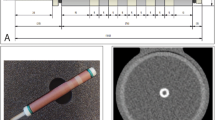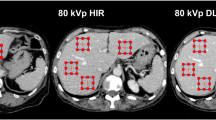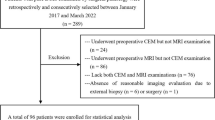Attenuation artifacts are the most common sources of error in myocardial single-photon emission computed tomography (SPECT) imaging. Breast artifacts are the most frequent causes of false positive planar images in female subjects. The purpose of this study was to predict breast adverse attenuation by measuring breast tissue thickness with digital x-ray. Sixty-five consecutive female patients with angina pectoris, who were referred to myocardial perfusion scintigraphy were enrolled in this study. Eighteen patients with normal perfusion imaging and normal coronary angiography composed the first group, whereas the second group consisted of 28 patients with a positive exercise electrocardiogram with anterior ischemia on myocardial perfusion imaging and greater than 50% left anterior descending artery stenosis on angiography. Nineteen patients in the third group had normal exercise electrocardiograms and normal coronary angiographies, but anterior ischemia on perfusion imaging. Digital x-ray records were obtained for measuring breast tissue thickness and Hounsfield density. The rate of breast adverse attenuation was 40% (19/47) in patients with anterior ischemia. The sensitivity and specificity of the prediction of breast adverse attenuation (lateral density less than 550 Hounsfield) were 79% and 11%, respectively. When breast attenuation for a breast thickness greater than 6 cm measured in the left anterior oblique view was predicted, the sensitivity and specificity were 79% and 93%, respectively. In conclusion, breast thickness greater than 6 cm measured from the left anterior oblique view with digital x-ray can predict breast adverse attenuation in female patients, and thereby may decrease the number of unnecessary invasive diagnostic procedures to be performed.


Similar content being viewed by others
References
Daher E, Dione DP, Heller EN, Holahan J, DeMan P, Shen M, Hu J, Sinusas AJ: Acute ischemic dysfunction alters coronary flow reserve in remote nonischemic regions: potential mechanical etiology identified in an acute canine model. J Nucl Cardiol 7:112–122, 2000
Lee DS, Jang MJ, Cheon GJ, Chung JK, Lee MC: Comparison of the cost-effectiveness of stress myocardial SPECT and stress echocardiography in suspected coronary artery disease considering the prognostic value of false-negative results. J Nucl Cardiol 9:515–522, 2002
Garver PR, Wasnich RD, Shibuya AM, Yeh F: Appearance of breast attenuation artifacts with thallium myocardial SPECT imaging. Clin Nucl Med 10:694–696, 1985
Tate JR, Cann CE: High-resolution computed tomography for the comparative study of fossil and extant bone. Am J Phys Anthropol 58:67–73, 1982
Kopp AF, Schroeder S, Baumbach A, Kuettner A, Georg C, Ohnesorge B, Heuschmid M, Kuzo R, Claussen CD: Non-invasive characterisation of coronary lesion morphology and composition by multislice CT: first results in comparison with intracoronary ultrasound. Eur Radiol 11:1607–1611, 2001
American College of Sports Medicine: Guidelines for Graded Exercise Testing and Exercise Prescription, 4th edition. Philadelphia: Lea & Febiger, 1991
Mahmarian JJ, Moye LA, Verani MS, Bloom MF, Pratt CM: High reproducibility of myocardial perfusion defects in patients undergoing serial exercise thallium-201 tomography. Am J Cardiol 75:1116–1119, 1995
Bashore TM, Bates ER, Berger PB, Clark DA, Cusma JT, Dehmer GJ, Kern MJ, Laskey WK, O’Laughlin MP, Oesterle S, Popma JJ, O’Rourke RA, Abrams J, Bates ER, Brodie BR, Douglas PS, Gregoratos G, Hlatky MA, Hochman JS, Kaul S, Tracy CM, Waters DD, Winters, Jr, WL: American college of cardiology. Task force on clinical expert consensus documents. American college of cardiology/society for cardiac angiography and interventions clinical expert consensus document on cardiac catheterization laboratory standards. A report of the American College of Cardiology Task Force on Clinical Expert Consensus Documents. J Am Coll Cardiol 37:2170–2214, 2001
Hermiller JB, Cusma JT, Spero LA, Fortin DF, Harding MB, Bashore TM: Quantitative and qualitative coronary angiographic analysis: review of methods, utility, and limitations. Catheter Cardiovasc Diagn 25:110–131, 1992
Maddahi J, Kiat H, Van Train KF, Prigent F, Friedman J, Garcia EV, Alazraki N, DePuey EG, Nichols K, Berman DS: Myocardial perfusion imaging with technetium-99 m sestamibi SPECT in the evaluation of coronary artery disease. Am J Cardiol 66:55–62, 1990
Thompson RC, Heller GV, Johnson LL, Case JA, Cullom SJ, Garcia EV, Jones PG, Moutray KL, Bateman TM: Value of attenuation correction on ECG-gated SPECT myocardial perfusion imaging related to body mass index. J Nucl Cardiol 12:195–202, 2005
Utsunomiya D, Tomiguchi S, Shiraishi S, Yamada K, Honda T, Kawanaka K, Kojima A, Awai K, Yamashita Y: Initial experience with X-ray CT based attenuation correction in myocardial perfusion SPECT imaging using a combined SPECT/CT system. Ann Nucl Med 6:485–489, 2005
Cohen M, Touzery C, Cottin Y, Benoit T, d’Athis P, Roy S, Louis P, Wolf JE, Rigo P, Brunotte F: Quantitative myocardial thallium single-photon emission computed tomography in normal women: demonstration of age-related differences. Eur J Nucl Med 1:25–30, 1996
Hansen CL, Woodhouse S, Kramer M: Effect of patient obesity on the accuracy of thallium-201 myocardial perfusion imaging. Am J Cardiol 6:749–752, 2000
Buus NH, Bottcher M, Bottker HE, Sorensen KE, Nielsen TT, Mulvany MJ: Reduced vasodilator capacity in syndrome X related to structure and function of resistance arteries. Am J Cardiol 83:149–154, 1999
Eriksson BE, Jansson E, Kaijser L, Sylven C: Impaired exercise performance but normal skeletal muscle characteristics in female syndrome X patients. Am J Cardiol 84:176–180, 1999
Author information
Authors and Affiliations
Corresponding author
Rights and permissions
About this article
Cite this article
Nurkalem, Z., Sahin, S., Uslu, N. et al. Predicting Breast Attenuation in Patients Undergoing Myocardial Perfusion Scintigraphy: A Digital X-Ray Study. J Digit Imaging 21, 446–451 (2008). https://doi.org/10.1007/s10278-007-9048-1
Received:
Revised:
Accepted:
Published:
Issue Date:
DOI: https://doi.org/10.1007/s10278-007-9048-1




